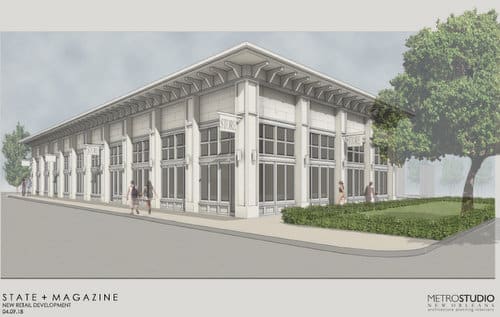
Courtesy of MetroStudio
An architect’s rendering of the retail development planned for the corner of State and Magazine Street. (image courtesy of Sherman Strategies)
A small retail development anchored by a corner coffee shop is the planned future of the vacant lot left by the demolition of the former Shell gas station at the corner of State and Magazine streets, developers told neighbors Wednesday night.
The 7,500 square foot building would house two or three shops at most, likely with a coffee shop facing the corner, attorney Michael Sherman and developer Clay Cambre told the Audubon Riverside Neighborhood Association at their monthly meeting on Wednesday.
“Everyone keeps saying ‘coffee,'” Sherman said. “We agree. That would be a great fit.”
The project will also include 18 parking spots in the rear — even though none are required by the city code — in order to help ease the general parking struggles along that upper end of Magazine Street, the developers said. In fact, the development will not need any land-use changes, as the developers looked at the existing zoning for the parcels in order to determine what kind of development might fit there, instead of dreaming up the project first and then trying to fit it in the zoning.
A restaurant would likely be difficult to fit in the space, for example, and perhaps not needed given the proliferation of restaurant locations nearby, Sherman said. Likewise, no bar or alcohol-serving establishment is even being considered.
“This is not a case where we’re trying to look for anything more than is permitted,” Sherman said. “We’re looking at the zoning laws to guide what we want to do.”
No tenants have been chosen for the project yet, although the developers are already beginning those conversations.
“We would love locals,” Cambre said in response to one association member’s question. “We have the agent working, beating the pavement now looking for tenants to fill it up.”
If the developers do secure a coffee shop, they are enthusiastic about trying to include some outdoor seating along the State Street side, Sherman said. The architect’s rendering of the project shows a wide green space between the building and State Street (with a huge tree in the center), and Sherman said it is not an artistic embellishment: the city actually controls that unusually wide swath of property, which makes an ideal setting for outdoor seating.
“It’s a great opportunity — if it is a coffee shop — to have a few outdoor tables,” Sherman said.
The design of the project is meant to complement Uptown architecture without simply mimicking it, Cambre noted. The project also has to walk the tightrope of enhancing a pedestrian-oriented, urban neighborhood that already struggles with traffic problems — hence the parking lot in the rear, mostly out of sight, with the shops’ facades lining the sidewalks.
The project currently includes access to the parking lot behind the building from both Magazine and State streets, which Sherman said was the format suggested by the city’s traffic engineers. No drive-through is planned — or would even be allowed by the city, the developers said — but if neighbors have ideas on the best ways to orient the traffic flow, the developers want to incorporate them.
Neighbors voiced no objections at the Audubon-Riverside meeting, and only posed a few curious questions about design choices and other issues. Austin Lavin, for example, asked the developers if they have a concrete timeline for the project.
The property technically included parcels under ownership by two different entities, and the first step for developer Brian Gibbs has been to unite them, Sherman explained. Developers will not actually be buying the parcel, but instead engaging in a long-term lease, and those details are still being worked out.
Since no zoning action is expected, the leasing negotiations are expected to take about six more months, Cambre said. Construction will likely take about nine months after that, allowing the shops to begin opening late next year.